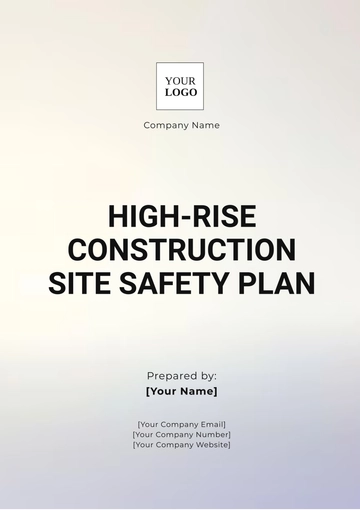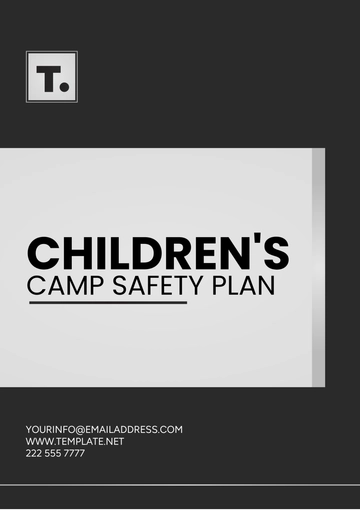Free Hospital Site Safety Format Plan

1. Introduction
This Hospital Site Safety Format Plan serves as a framework for ensuring the safety and well-being of all individuals within the hospital premises of [Your Company Name], including patients, staff, and visitors. The plan identifies potential hazards, outlines emergency procedures, and establishes a culture of safety.
2. Objectives
To create a safe environment for patients, staff, and visitors.
To establish protocols for responding to various emergencies.
To ensure compliance with safety regulations and standards.
To promote continuous safety training and awareness.
3. Risk Assessment
3.1 Identification of Hazards
Physical Hazards: Slips, trips, falls, and equipment malfunctions.
Biological Hazards: Exposure to infectious diseases and biohazardous materials.
Chemical Hazards: Spills and exposure to hazardous substances.
Environmental Hazards: Natural disasters, fire hazards, and electrical failures.
3.2 Risk Evaluation
Each identified hazard will be assessed for its potential impact and likelihood of occurrence. High-risk areas will be prioritized for immediate action.
4. Emergency Procedures
4.1 Fire Emergency
Evacuation Plan: Marked exits and evacuation routes will be established and communicated.
Fire Drills: Regular fire drills will be conducted to ensure staff readiness.
Fire Extinguishers: Accessible fire extinguishers will be placed throughout the facility, and staff will receive training on their use.
4.2 Medical Emergency
Code Blue Response: Protocols for responding to cardiac arrest or severe medical emergencies.
Communication System: Clear communication lines for alerting medical staff and emergency responders.
4.3 Natural Disasters
Disaster Response Plan: Guidelines for responding to earthquakes, floods, or severe weather conditions.
Emergency Supplies: Adequate stock of emergency supplies, including first-aid kits, food, and water.
5. Roles and Responsibilities
Role | Responsibilities |
|---|---|
Safety Officer | Develops and updates the safety plan, conducts audits, ensures compliance with regulations, and coordinates emergency response training. |
Department Heads | Ensures safety protocol compliance, organizes tailored training sessions, conducts safety meetings, and acts as a liaison with the Safety Officer. |
All Staff | Participates in training and drills, reports hazards immediately, follows safety protocols and promotes a culture of safety. |
6. Training Requirements
Orientation Training: New staff will undergo safety orientation upon hire.
Annual Safety Training: All staff will participate in annual safety training to refresh knowledge on protocols and procedures.
Specialized Training: Additional training for staff in high-risk areas (e.g., emergency room, operating room).
7. Communication Plan
Safety Meetings: Regular safety meetings will be held to discuss concerns and improvements.
Bulletin Boards: Safety information will be posted in staff areas for easy access.
Incident Reporting: A streamlined process for reporting safety incidents and near-misses will be established.
8. Monitoring and Review
Regular Audits: Safety audits will be conducted quarterly to assess compliance and effectiveness.
Incident Analysis: Review of safety incidents to identify trends and areas for improvement.
Plan Updates: The safety plan will be reviewed annually and updated as necessary to incorporate new regulations and practices.
9. Conclusion
The implementation of this Hospital Site Safety Format Plan is essential for fostering a safe environment within the hospital. By adhering to established protocols, training staff, and maintaining clear communication, we can ensure the well-being of all individuals on the premises.
- 100% Customizable, free editor
- Access 1 Million+ Templates, photo’s & graphics
- Download or share as a template
- Click and replace photos, graphics, text, backgrounds
- Resize, crop, AI write & more
- Access advanced editor
Elevate safety standards in your healthcare facility with the Hospital Site Safety Format Plan Template from Template.net. This editable and customizable template provides a structured approach to ensure the safety of patients and staff. Tailor the content to align with your hospital's specific safety protocols and regulatory requirements. With its clear design and comprehensive guidelines, you can effectively communicate essential safety measures, fostering a secure environment for everyone.
You may also like
- Finance Plan
- Construction Plan
- Sales Plan
- Development Plan
- Career Plan
- Budget Plan
- HR Plan
- Education Plan
- Transition Plan
- Work Plan
- Training Plan
- Communication Plan
- Operation Plan
- Health And Safety Plan
- Strategy Plan
- Professional Development Plan
- Advertising Plan
- Risk Management Plan
- Restaurant Plan
- School Plan
- Nursing Home Patient Care Plan
- Nursing Care Plan
- Plan Event
- Startup Plan
- Social Media Plan
- Staffing Plan
- Annual Plan
- Content Plan
- Payment Plan
- Implementation Plan
- Hotel Plan
- Workout Plan
- Accounting Plan
- Campaign Plan
- Essay Plan
- 30 60 90 Day Plan
- Research Plan
- Recruitment Plan
- 90 Day Plan
- Quarterly Plan
- Emergency Plan
- 5 Year Plan
- Gym Plan
- Personal Plan
- IT and Software Plan
- Treatment Plan
- Real Estate Plan
- Law Firm Plan
- Healthcare Plan
- Improvement Plan
- Media Plan
- 5 Year Business Plan
- Learning Plan
- Marketing Campaign Plan
- Travel Agency Plan
- Cleaning Services Plan
- Interior Design Plan
- Performance Plan
- PR Plan
- Birth Plan
- Life Plan
- SEO Plan
- Disaster Recovery Plan
- Continuity Plan
- Launch Plan
- Legal Plan
- Behavior Plan
- Performance Improvement Plan
- Salon Plan
- Security Plan
- Security Management Plan
- Employee Development Plan
- Quality Plan
- Service Improvement Plan
- Growth Plan
- Incident Response Plan
- Basketball Plan
- Emergency Action Plan
- Product Launch Plan
- Spa Plan
- Employee Training Plan
- Data Analysis Plan
- Employee Action Plan
- Territory Plan
- Audit Plan
- Classroom Plan
- Activity Plan
- Parenting Plan
- Care Plan
- Project Execution Plan
- Exercise Plan
- Internship Plan
- Software Development Plan
- Continuous Improvement Plan
- Leave Plan
- 90 Day Sales Plan
- Advertising Agency Plan
- Employee Transition Plan
- Smart Action Plan
- Workplace Safety Plan
- Behavior Change Plan
- Contingency Plan
- Continuity of Operations Plan
- Health Plan
- Quality Control Plan
- Self Plan
- Sports Development Plan
- Change Management Plan
- Ecommerce Plan
- Personal Financial Plan
- Process Improvement Plan
- 30-60-90 Day Sales Plan
- Crisis Management Plan
- Engagement Plan
- Execution Plan
- Pandemic Plan
- Quality Assurance Plan
- Service Continuity Plan
- Agile Project Plan
- Fundraising Plan
- Job Transition Plan
- Asset Maintenance Plan
- Maintenance Plan
- Software Test Plan
- Staff Training and Development Plan
- 3 Year Plan
- Brand Activation Plan
- Release Plan
- Resource Plan
- Risk Mitigation Plan
- Teacher Plan
- 30 60 90 Day Plan for New Manager
- Food Safety Plan
- Food Truck Plan
- Hiring Plan
- Quality Management Plan
- Wellness Plan
- Behavior Intervention Plan
- Bonus Plan
- Investment Plan
- Maternity Leave Plan
- Pandemic Response Plan
- Succession Planning
- Coaching Plan
- Configuration Management Plan
- Remote Work Plan
- Self Care Plan
- Teaching Plan
- 100-Day Plan
- HACCP Plan
- Student Plan
- Sustainability Plan
- 30 60 90 Day Plan for Interview
- Access Plan
- Site Specific Safety Plan





























